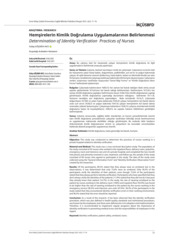Hemşirelerin Kimlik Doğrulama Uygulamalarının Belirlenmesi
-
Tür
Makale
- Yayın Tarihi 2021
-
Yayıncı
İzmir Kâtip Çelebi Üniversitesi Sağlık Bilimleri Fakültesi
- Dergi Adı İzmir Katip Çelebi Üniversitesi Sağlık Bilimleri Fakültesi Dergisi 2, ( 6 ), pp.71 - 76
- Tek Biçim Adres https://hdl.handle.net/11469/2107
-
Konu Başlıkları
Kimlik doğrulama
Hasta güvenliği
Kol bandı
Hemşirelik
Dentitiy verification
Patient safety
Armband
Nursing
Amaç: Bu çalışma özel bir hastanede çalışan hemşirelerin kimlik doğrulama ile ilgili uygulamalarını belirlemek amacıyla yapılmıştır.
Gereç ve Yöntem: Çalışma, kesitsel tanımlayıcı türde bir çalışmadır. Çalışmanın evrenini özel bir hastanenin yatan hasta katları, doğumhane, poliklinikler, acil servis ve yoğun bakımında çalışan, iki aylık deneme süresini doldurmuş, hasta bakım, tedavi ve izleminde birebir yer alan 92 hemşire, örneklemini çalışmaya katılmayı kabul eden 84 hemşire oluşturmuştur. Çalışmanın verileri, araştırmacı tarafından oluşturulan “Genel Bilgi Formu” ve “Kimlik Doğrulama İzlem Formu” kullanılarak toplanmıştır.
Bulgular: Çalışmada katılımcıların %89,3’ü her zaman kol bandı taktığını ifade etmiş ancak yapılan gözlemlerde %72,6’sının kol bandı taktığı belirlenmiştir. Katılımcıların %72,6’sı her zaman kimlik doğrulama yaptığını belirtmesine karşın %58,3’nün kimlik doğrulaması yaptığı görülmüştür. Kimlik doğrulaması yapmadığı durumların olduğunu belirtenler (%11,9), hastasını tanıdığını için doğrulama yapmadığını ifade etmişlerdir (%16,7). Çalışmada doğumhane (%100) ve yatan hasta katlarında (%93,9) çalışan hemşirelerin kol bandı takma oranı acil servis (%38,5) ve yoğun bakımda (%47,6) çalışan hemşirelerin kol bandı takma oranından yüksek bulunmuştur. Çalışamaya katılanların %58,3’ü çalışma ortamlarında kimlik doğrulama hatası ile karşılaştıklarını, %96,4’ü ise yapılan hatanın bildirilmesi gerektiğini belirtmişlerdir.
Sonuç: Çalışma sonucunda, sağlıkta kalite standartları ve kurum prosedürlerinde tanımlı olan kimlik doğrulama prosedürünün çalışanlar tarafından bilindiği ancak benimsenmesi ve uygulanması noktasında eksiklikler olduğu görülmüştür. Bu nedenle tıbbi hataların önlenmesinde kimlik doğrulamanın önemi ve çalışanların bu konudaki sorumlulukları hakkında düzenli programlar uygulanması önerilir.
Objective: This study was conducted to determine the practices of nurses working in a private hospital related to identitiy verification. Material and Method: This study was a cross-sectional descriptive study. The population of the study consisted of 92 nurses who worked in the inpatient floors, delivery room, polyclinic, emergency room and intensive care unit of a private hospital, and completed the two-month trial period, and primarily involved in care, treatment, and follow-up, the sample of the study consisted of 84 nurses who agreed to participate in the study. The data of the study were collected using the “General Information Form” and “Identitiy Verification Observation Form” created by the researcher. Results: Of the participants, 89.3% stated that they always wear an armband, but in the observations, it was determined that only 72.6% wore an armband. Only 58.3% of the participants verify the identities of their patients, even though 72.6% of the participants stated that they always perform identity verification. Participants who have specified that they don’t always verify the identities of the patients (11.9%) stated that they did not do it because they already knew their patient (16.7%). In the study, the rate of wearing wristband to the patient by nurses working in the delivery room (100%) and inpatient floor (93.9%) was found to be higher than the rate of wearing wristband to the patient by the nurses working in the emergency service (38.5%) and intensive care units (47.6%). 58.3% of the participants in the study stated that they encountered identity verification errors in their working environment, and 96.4% stated that the error should be reported. Conclusion: As a result of the research, it has been observed that the identity verification procedure, which was also defined in health quality standards and institutional procedures, was known by the employees, but there were deficiencies in its adoption and implementation. Therefore, it is recommended to implement regular programs about the importance of identitiy verification in preventing medical errors and the responsibilities of employees in this regard.
-
Koleksiyonlar
FAKÜLTELER
SAĞLIK BİLİMLERİ FAKÜLTESİ

 Tam Metin
Tam Metin

